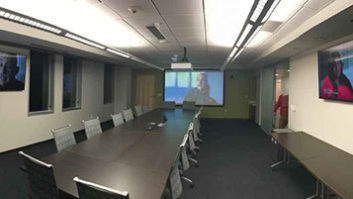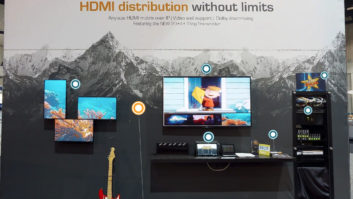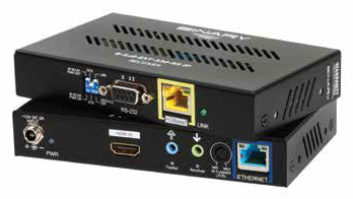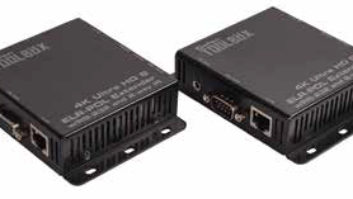This Integration Guide was sponsored by Atlona, DVIGear, Rose Electronics, Shinybow USA, and Zigen as a supplement to Residential Systems, January 2016.
In signal distribution, matrix switchers are prized possessions. Routing audio and video content to multiple sources and components in the home or controlling the output of a home theater or media room cannot be adequately accomplished without the help of a good switcher—and often the aid of a knowledgeable custom integrator.

Just Add Power has a range of 3G Ultra HD over IP receivers that can downscale 4K signals with HDCP 2.2 to 1080p for display on HDMI 1.x screens and also upscale 1080p and lower signals to 2160p for 4K TVs with HDCP 2.2.
Over the past several years, switchers have undergone a series of improvements and augmentations, each iteration influenced by technology forecasts that are years in the making. HDMI 2.0 has arrived to accommodate greater bandwidth capabilities. 4K, the standard that everyone in both residential and commercial integration have anticipated and prepared for, is finally sweeping into consumer consciousness, and with that we see matrix switchers across the board with reflective data rates of 4K@60Hz.
“The key to integrating 4K standards like UHD and DCI into centralized distribution products like switchers and distribution amplifiers is making sure your products are open enough to support the stages of evolution without becoming obsolete,” said Chris Bundy, product manager for Gefen, which is now under the Core Brands umbrella. “The drive to create a switch with a fast enough cross point to support full UHD 4K with 10-bit color and 4:4:4 subsampling is currently the bleeding edge of signal distribution technology. The next frontier is a transport format that has enough bandwidth to deliver the same full UHD 4K at distance. HDBaseT 2.0 is the frontrunner, and promises a reliable means to create centralized distributed AV without sacrificing quality or creating a bottleneck for high-resolution signals.”

For the past two years, nearly all of Atlona’s products, like the AT-UHD-PRO3- 1616M, have supported the current 4K standards including the 4K@60Hz with 4:2:0 color subsampling standard.
With 4K distribution comes headaches around HDCP 2.2, the latest content protection standard established by Hollywood to prevent piracy. Not all 4K signal distribution products are HDCP 2.2 compliant, which could raise issues when it comes to integrating non-4K and older devices in a system that features 4K content.
“Most switching products in the industry, regardless of manufacturer, support 4K natively,” noted Cameron C. Smith, VP of technology for Liberty AV. “They do not support HDCP 2.2, though this is becoming more common. The limitation is typically in the transport of the signals—the cables, connectors, extenders, etc. In the case of modular and card-based matrices, it’s the cards that don’t support the high bandwidth, not the matrix itself. We believe one of the most interesting trends involves connectivity—how the matrix connects to the sources and destinations. We’ve seen a growing demand for AOC (active optical cables) and fiber optics, including both cable and transceivers, to ensure the infrastructure will support 4K today and the high-bandwidth formats of the future.”
WHAT’S ON THE MARKET
DVIGear, in considering AV matrix switcher functionality, has two questions that it believes integrators should ask: What is the best transport medium for future AV systems? Should they continue to rely on proprietary AV matrix switchers or is there a better solution? Steven Barlow, president of DVIGear believes that the company’s DisplayNet answers both of these questions as a platform that supports multiple applications, including point-to-point extension, limitless matrix switching, video wall display, and multi-viewer, which is coming in 2016.

DVIGear’s DisplayNet offers a platform that supports multiple applications, including pointto- point extension, limitless matrix switching, video wall display, and multi-viewer.
“For years, the proprietary matrix switcher has been the cornerstone of large-scale AV systems,” Barlow noted. “This model is changing. System integrators can now use DVIGear’s DisplayNet technology to transport uncompressed AV signals over standard off-the-shelf 10 Gb ethernet network switches. Rather than aggregating all the AV to a central AV matrix switch, this approach allows the AV assets to remain at the source and destination locations while the signal transport is performed over IT technology. Essentially, the system becomes what can be called a “distributed matrix switcher.”
For the past two years, nearly all of Atlona’s products have supported the current 4K standards including the 4K@60Hz with 4:2:0 color subsampling standard, with Bill Schripsema, the company’s senior product manager noting that support for 4K@60 Hz with 4:4:4 color and products that support 4:2:0 subsampling with greater color depth (HDR) are on the horizon, though those data rates are not currently supported by HDBaseT technology. Among their current stock, however, integrators have taken to Atlona’s UHD-PRO3 switchers.
“They feature support for HDCP 2.2 sources, 4K@60 4:2:0, and analog audio outputs with adjustable gain and EQ to make them ideal install pieces,” Schripsema said. “They are available in 4×4, 6×6, 8×8, and 16×16 sizes. With HDMI inputs and a mix of HDMI, 70-meter (230 feet) HDBaseT and 100-meter (328 feet) HDBaseT outputs, they offer a very attractive value proposition.”
Crestron, whose DigitalMedia platform has supported 4K since 2008, has kept abreast of standards with DM also now supporting HDCP 2.2. Crestron’s DM switches, ranging from the 8×8 to the 128×128, are considered the most integrator-friendly of their line because of their flexibility, according to Justin Kennington, technology manager of DigitalMedia.
“Need more I/O or fewer? Only buy the card you need,” Kennington explained. “New standard hits the market (like 4K, or HDCP 2.2)? Just upgrade the cards you need to; don’t throw out the whole switch. These switches also feature installer-friendly features like simultaneous distribution of multi-channel and two-channel audio, and down-mixed audio loop-outs for easy integration of DigitalMedia with whole-home audio distribution.”
For Gefen, the EXT-UHD-88 is the standard switcher for many of their integrators. The 4K Ultra HD 8×8 matrix for HDMI routes eight 4K sources to any combination of up to eight 4K displays, Bundy noted, adding, “It supports resolutions up to 4K Cinema-DCI and 4K Ultra HD at 60 Hz and can handle 30 Hz with 4:4:4 subsampling. It is also one of the few switches on the market that is compliant with the latest HDCP 2.2 protocol as well as HDCP 1.4.”

The Gefen EXT-UHD-88 4K Ultra HD 8×8 matrix for HDMI routes eight 4K sources to any combination of up to eight 4K displays and supports resolutions up to 4K Cinema-DCI and 4K Ultra HD at 60 Hz.
Recognizing early on that built-in signal management and scaling would be key to offering a flexible 4K distribution solution, Just Add Power has a range of 3G Ultra HD over IP receivers that can downscale 4K signals with HDCP 2.2 to 1080p for display on HDMI 1.x screens and also upscale 1080p and lower signals to 2160p for 4K TVs with HDCP 2.2 to meet the needs of homes that feature a mix of 4K products, older 1080p and 720p models, and non-4K devices such as Apple TVs.
“3G Ultra HD over IP has been making waves within video distribution, because it offers far more flexibility than fixed-format and card-based options can,” said Ed Qualls, president of Just Add Power. “3G Ultra HD over IP can facilitate any size of 4K video matrixing application—any number of inputs and outputs is possible. Dealers can use 3G Ultra HD over IP to send 4K@60Hz 4:2:0 / UHD content with HDCP 2.2, as well as Full HD 1080p and lower content, to multiple displays (HDMI 2.0 or HDMI 1.x) throughout a home—all over a gigabit managed network using standard Cat-5e/6 cabling. No additional signal management hardware is required, no playing around with long-length HDMI cables, no mandatory upgrade to fiber (though you can use fiber).”
Control4 currently offers a new line of 4K UHD matrix switches that use HDBaseT technology to distribute 4K content, including copy-protected content, to every room in the Control4 Smart Home without the need for additional hardware or software. Among these is the brand’s premium model, the LU1082, which is capable of distributing 10 HDMI 4K UHD sources to eight zones.

Control4 currently offers a new line of 4K UHD matrix switches that use HDBaseT technology to distribute 4K content, including copy-protected content, to every room in the Control4 Smart Home.
“The integrated audio matrix combines audio extracted from the 10 HDMI sources with eight independent coaxial digital inputs to create an 18-source-by-eightzone audio solution, with variable volume, bass, and treble controls and audio delay for lip sync correction,” said Brad Hintz, director of product marketing at Control4. “Ten total audio zones can be served when AV receivers are connected to the local HDMI outputs. Fast switching times are achieved thanks to Control4’s advanced EDID management system EZ-Calibration. Zone Lock technology ensures home theater and media rooms are able to take full advantage of the latest 7.1 HD audio codecs. The bottom line is that this unit is very comprehensive to solve all of an integrator’s unique installation challenges.”
Addressing the switcher market as AV over IP instead of what Jonathan Ralston calls “conventional discrete switcher configurations,” Transformative Engineering has sought to circumvent the issue of obsolescence that often accompanies new standards by bringing to market 4K AV-Over-IP products with full UHD capacity.

Transformative Engineering has sought to circumvent the issue of obsolescence that often accompanies new standards by bringing to market 4K AV-Over-IP products with full UHD capacity.
“Based on the overwhelming response our current 1080p AV-over-IP matrix switching solution, the HXU-1, has received, we will be introducing a 4K AV-over-IP architecture capable of delivering 4K@60Hz/4:4:4 color space,” said Ralston, who is director of sales for Transformative Engineering. “It will include our typical suite of functionality (IR, RS-232, etc). Most importantly to our dealers, it will provide exceptionally high performance and reliability, which we will reinforce with our unparalleled technical support.”
Most of Liberty AV’s products already support 4K, but Smith pointed to a trend he has noticed among residential system integrators: the tackling of light commercial projects in which they implement Liberty AV’s range of distribution products.

Liberty AV has been designing products around connectivity, to meet the growing demand for compatibility with AOC (active optical cables) and fiber optics, including both cable and transceivers.
“There has been a huge increase in presentation switcher sales due to the rise of automation and decrease in scaling and processing technology,” Smith said. “For example, an auto-switcher that combines switching, scaling, up to eight diverse inputs, and audio processing retails for less than $500.”
The EVMX4K08 8×8 HDBaseT Matrix, manufactured by Vanco, passes 4K signals at 30/60 Hz and features an integrated touchscreen front panel with IR, IP, and RS-232 control as well as PoE compatibility to power the company’s slim-line EVRXHD1 receivers and mirror outputs.
“From a unique standpoint our EVMX44SL 4×4 seamless matrix with video-wall and multi-view capabilities is a huge hit as well,” noted Mark Corbin, Vanco’s director of distribution market. “Capable of accepting any four HDMI/ VGA/composite inputs, up/downscaling the image out to the display HDMI. Once connected you have functionality of combining four TVs to perform a video wall or use the other mode as a multi-view format for digital signage or multi-screen options.”

Vanco’s EVMX44SL 4×4 seamless matrix with video wall and multi-view capabilities can accept any four HDMI/VGA/composite inputs, up/downscaling the image out to the display HDMI.
At CEDIA 2015, Zigen launched several new products, including a new family of HDMI 2.0 4K UHD 18 Gbps products as well as two switchers, a distribution amp, and a “buffer” to help integrators manage the transition from previous HDCP schemes.
“Our 4K modular matrices are the perfect choice for integrators,” said Jeff Murray, Zigen’s VP of sales. “4K UHD, HDMI, and HDBaseT 228-foot and 328-foot option cards are available. All versions of HDCP are covered and these switches are field proven over the past three years—they work! Third-party control drivers are available to integrators for Savant, Control4, Crestron, AMX, RTI, ELAN, and more.”
KanexPro’s HDMX44-4K and the HDMX88-8K HDMI matrices are designed to deliver an immersive 4K@60Hz video with fast switching. For integrators looking to extend via HDBaseT, company senior product manager Kashyap Khetia, recommends the MX-HDBASE Series.

KanexPro’s HDMX44-4K and the HDMX88-8K HDMI matrices are designed to deliver an immersive 4K@60Hz video with fast switching.
“The new, ultra-fast HDMX44-4K and HDMX88-4K matrices support HDCP 2.2 and audio de-embedding capabilities with SPDIF outputs to Dolby Digital, DTS, and DTS-HD,” Khetia explained. “They are super easy to install into any residential application and provide rack-mounting options, locking power supply, and control options via web-based GUI, IR, or RS-232 designed to work with any third-party control systems.”
PureLink, which has been proactively revising its entire catalog of products to support 4K, from its extenders, adapters, displays, and full line of matrix switchers, has had success with its PM series.
“With its support of cross-platform signals, Full HD and Ultra HD, along with fiber and HDBaseT extension, 4K up/down scaling, and more, we have found the PM series to be a complete solution for small- and large-scale matrix routing, processing, and extension requirements in various markets and applications,” noted Keith Frey, senior product manager at PureLink.
Metra Home Theater manufacturers HDMI switchers as opposed to the traditional matrix switchers, and the company’s CS-HDM5X1SW HDMI switcher has been a favorite with integrators as it allow integrators to use them on small jobs, while leaving the option to add more sources in the future as customers expand their systems.

Metra Home Theater manufacturers HDMI switchers as opposed to the traditional matrix switchers, and the company’s CS-HDM5X1SW HDMI switcher allows integrators flexibility for small jobs with the option to expand.
“Going the distance is clearly the most sought-after requirement our customers need,” said Stephanie Casimiro, marketing director for Metra. “Now, with the bandwidth practically doubling when fully matured, both legacy and newly installed systems will demand a transmission line that can support all the new functions supported under HDMI Rev 2.0 and 4K. We are the first to have developed a device that accomplished this and are now providing the necessary education for integrators to adapt to these new standards. The goal is to continue in developing products like switching devices that can hold the same standard.”
A-Nuetronics’ new switchers offer support for 4K@60Hz, but the company will also be introducing a line of affordable 4K@60Hz fiber optic matrix routers to address HDMI extended distance issues.
“Our line of matrix routers will continue offering options such as external SPDIF audio outputs where the audio is sampled on each router channel and/or HDBaseT outputs, in addition to HDMI,” said James Jobin, operations manager for A-Nuetronics. These options allow custom integrators more flexibility in signal management. We will also have a product line that supports a modular option for the second channel output. While output number one is fixed with an HDMI connector, the second channel will support HDMI, HDBaseT, SDI, fiber, or coax.”
WyreStorm has offered 4K HDBaseT extender sets and HDBaseT and HDMI matrices since early 2015 for early 4K adopters. The arrival of broadcast standards such as 4K@60Hz with 24bit 4:2:0 color and HDCP 2.2 was significant, according to product application specialist Dave Schorah, as it means that 4K distribution products needed to contain chipsets supporting this new specification and encryption to be compatible with the next generation of source devices and content such as 4K Blu-ray or streamed media.
“Manufactures that developed 4K products based on early chipsets that predated this standard run the risk of incompatibility with sources and content, which is why we ensured all our 4K solutions contain the latest generation of encryption chip to ensure that future compatibility.”
In addition to its existing 4K range, WyreStorm has another five matrix switchers and four extender products supporting 4K@60hz and HDCP 2.2, so the company is starting 2016 with a range of products.
BEYOND 4K
It is difficult to talk about custom integration without nodding toward the connected home, and by extension, the Internet of Things. Matrix switching, by the very nature of its purpose, has to keep up with, and in many instances, surpass the requirements of any given AV project in which it is implemented. Already a networking device, the matrix switcher is moving into the IT space to fully embrace where systems technology is headed—a direction that several manufacturers including DVIGear, Atlona, Metra Home Theater, Crestron, PureLink, KanexPro, Transformative Engineering, and WyreStorm are taking.
“The IoT narrative reinforces our view that VLAN-type AV-over- IP technology is the future of matrix (and source) switching,” noted Ralson of Transformative Engineering. “This allows the two disciplines to merge, support each other, and create a seamless interface for the installer and user. There will be new base technologies arriving in the next year or two that will greatly expand this category. This only makes the knowledge and skills associated with network technologies all the more important for manufacturers, distributors, dealers, and installers—the entire AV “food chain” needs to be well trained in everything network related.”
Llanor Alleyne is a contributing editor to Residential Systems.







